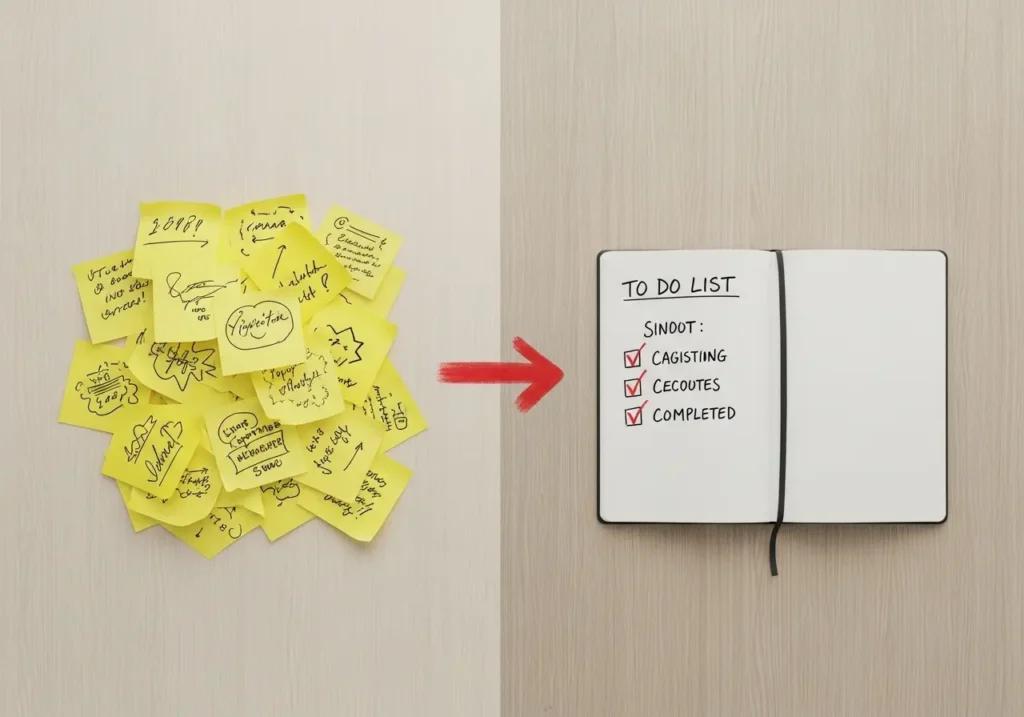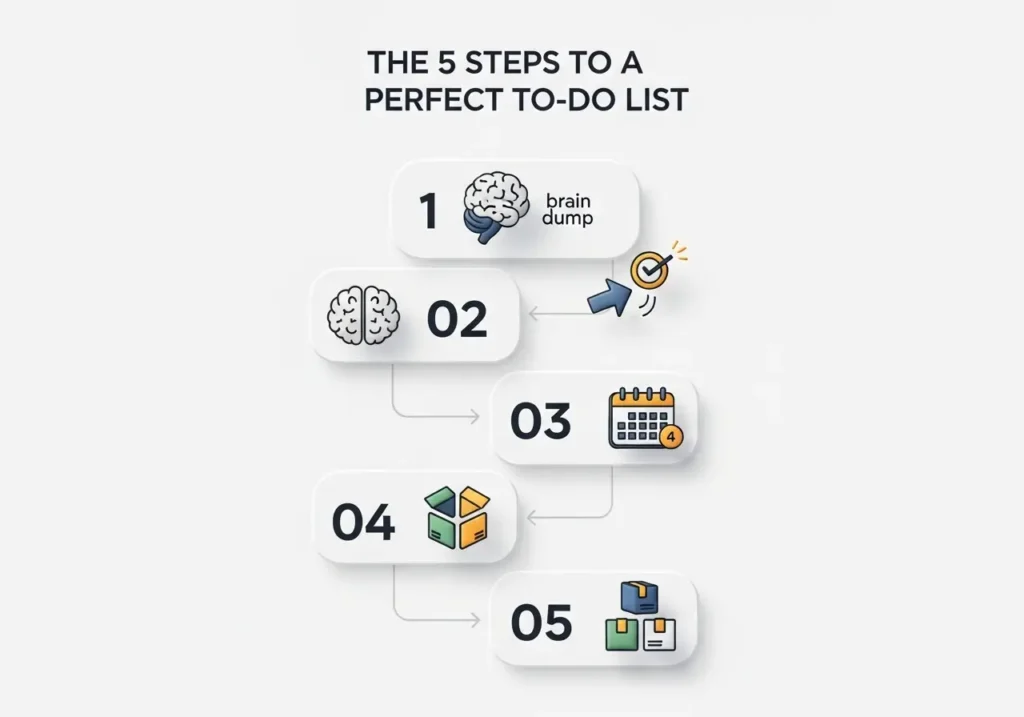
Does this sound familiar? You have to-do lists scattered everywhere: on sticky notes covering your monitor, in your phone’s notes app, buried within a project management tool, and jotted down in a half-used notebook. You spend your day feeling incredibly busy, rushing from one “urgent” thing to the next. But at the end of it, you collapse with a sense of unease, not sure if you made any real progress on what truly matters.
This is the central problem with how most people use to-do lists. Without a clear, unified system, a tool that’s meant to bring clarity becomes a source of constant stress and overwhelm. It’s not a to-do list; it’s a “should-do” list—a nagging reminder of everything you haven’t accomplished.
This guide will change that. We’ll go beyond generic advice and give you a structured, realistic method for creating and managing to-do lists that actually work. We’ll cover the five fundamental steps to build your list, how to prioritize ruthlessly so you’re always working on the right things, and how to choose the right tool for your unique style.
What Does an “Effective” To-Do List Actually Mean?
Before we dive into the “how,” let’s define our goal. An effective to-do list is not just a long inventory of every possible task. It’s a curated, strategic document.
- It provides clarity, not chaos. A good list is a source of focus. It tells you exactly what to work on next, eliminating the mental energy wasted on deciding. A bad list is a chaotic brain dump that only increases your anxiety.
- It’s realistic, not wishful thinking. An effective list respects the laws of time. It reflects the actual, finite hours you have in a day, not an imaginary 40-hour workday.
- It drives action, not just thought. An effective list is composed of “next actions,” not “projects” or “things to worry about.” It’s a list of physical, visible actions you can take.
The 5 Fundamental Steps to Creating Your To-Do List

Building a powerful to-do list is a process. Follow these five steps to transform your chaotic list into a clear plan.
Step 1: Capture Everything (Get It Out of Your Head)
Your mind is for having ideas, not for holding them. The first and most crucial step is to get every single task, big or small, out of your head and into a trusted, external system. This is often called a “brain dump.”
- Why it works: Trying to remember everything you have to do creates dozens of “open loops” in your brain. This consumes a huge amount of background mental energy and creates a constant, low-grade stress. By capturing everything in one place, you give your brain permission to let go and focus on the task at hand.
- How to do it: Set aside 15-20 minutes. Grab a large piece of paper or open a blank digital document. Write down every single thing that has your attention, from “Finish the Q4 report” to “Buy dog food” to “Call Mom.” Don’t organize or filter yet. Just capture.
Step 2: Make Every Item Actionable (Start with a Verb)
A common mistake is to write down vague concepts or projects. “Mom’s birthday” is not a task. “Marketing campaign” is not a task. These are projects. An actionable task is the very next physical action you need to take. The easiest way to ensure this is to start every item on your list with a verb.
- Why it works: Verbs demand action. They remove ambiguity and tell your brain exactly what to do. This eliminates the small moment of friction and decision-making required to translate a vague idea into an action, making it much easier to start.
- Before: “Mom’s birthday”
- After: “Buy a birthday card for Mom.”
- Before: “Marketing campaign”
- After: “Draft the first version of the ad copy.”
Step 3: Assign Deadlines and Context
A task without a deadline is a dream that will likely never happen. Go through your list and assign a realistic due date to every actionable item. This helps you understand what needs to be done now versus what can wait. For extra clarity, you can also add context, like the name of the project it belongs to.
Step 4: Break Down Large Tasks into Sub-Tasks
A task like “Create the Q4 marketing presentation” is intimidating. It feels like a huge, multi-hour project, which makes it a prime candidate for procrastination. The solution is to break it down into smaller, more manageable steps.
- Why it works: Small tasks are not intimidating. Your brain doesn’t resist starting something that feels easy. By breaking down a large project, you can always identify a 15-minute task you can do right now to make progress.
- Before: “Create the Q4 marketing presentation”
- After (as a mini-project):
- Research data for Q4 report.
- Create an outline for the presentation.
- Design the first draft of the slides.
- Write the script for the presentation.
- Practice the presentation.
Step 5: Group Similar Tasks (Batching)
To increase your focus and efficiency, group similar tasks together. This is a technique known as “batching.”
- Why it works: Every time you switch between different types of tasks (e.g., from writing an email to making a phone call to analyzing a spreadsheet), your brain has to “reload” the context. This “context switching” is a huge drain on your mental energy. By batching similar tasks, you stay in one mode of thinking for longer, which leads to deeper focus and higher quality work.
- Example Batches:
- @Emails: A block of time dedicated only to answering emails.
- @Calls: A block for making all your necessary phone calls.
- @Writing: A focused period for writing reports or articles.
Prioritization: How to Decide What to Do First

Once you have a clear, actionable list, the most important skill is prioritization. A long to-do list is useless if you spend all your time on the easy, low-impact tasks.
The ABCDE Prioritization Method
This is a simple, fast, and effective way to organize your daily list, developed by productivity expert Brian Tracy.
- How it works: Go through your list and assign a letter to each task before you start working.
- A Tasks: Your most important tasks. These have serious positive or negative consequences if they are (or are not) done. These are your “frogs.”
- B Tasks: Tasks you should do. They have minor consequences.
- C Tasks: Tasks that are nice to do. They have no consequences if they are not done.
- D Tasks: Tasks you can Delegate.
- E Tasks: Tasks you can Eliminate.
- The Rule: The rule is simple but powerful: You never do a B task when an A task is still undone. You never do a C task before your B tasks are done. This simple hierarchy forces you to focus on what’s most important first.
The Eisenhower Matrix: The Ultimate Filter for Priorities
A more advanced method for strategic prioritization is to filter your tasks by urgency and importance.
- Quadrant 1: Urgent & Important (Do): Crises, hard deadlines. Do these now.
- Quadrant 2: Not Urgent & Important (Schedule): Strategic planning, learning, relationship-building. This is where long-term success is built. Schedule time for these.
- Quadrant 3: Urgent & Not Important (Delegate): Many interruptions and emails fall here. Delegate them if possible.
- Quadrant 4: Not Urgent & Not Important (Delete): Time-wasters. Eliminate them.
To apply this method instantly, use our free interactive Eisenhower Matrix Sorter to organize your list in seconds.
Choosing the Right Tool: Analog, Digital, or Hybrid?
The Power of Digital: Organization, Automation, and Collaboration
Digital apps like Todoist, Asana, or Notion are incredibly powerful for managing complex projects.
- Pros: They allow for recurring tasks, reminders, collaboration with team members, and syncing across all your devices. They are perfect for managing a large volume of information.
- Cons: They can sometimes be too complex, leading to “productivity porn” (spending more time organizing the tool than doing the work). The endless features can be a distraction.
The Satisfaction of Pen and Paper: Focus and Accomplishment
Never underestimate the power of a simple notebook and pen.
- Pros: The physical act of writing down your tasks and striking them through with a pen provides a deep, psychological sense of satisfaction and accomplishment. A paper list is also a finite, distraction-free environment.
- Cons: It’s not easily searchable, can’t be automated, and is difficult to share or collaborate on.
The Hybrid Approach: The Best of Both Worlds
Many highly productive people use a hybrid system. They use a digital tool as their “master database” to capture everything, but each day, they write down their 3-5 most important tasks on a physical piece of paper. This gives them the organizational power of digital with the focus of analog.
Advanced Tips for a To-Do List That Actually Works

- Plan Your List the Night Before: Spend the last 10 minutes of your workday planning your to-do list for the next day. This allows you to “close the loop” on your work, which reduces evening stress. It also means you can wake up and start your day with absolute clarity and momentum.
- Let Your Calendar Lead, Not Your List: This is the most important tip for a realistic list. Your calendar reflects your actual, finite time. Before you finalize your to-do list for the day, look at your calendar. If you have 5 hours of meetings, it’s completely unrealistic to have 10 major tasks on your list. Your to-do list must fit into the empty blocks of your calendar.
- The Ivy Lee Method (The “Top 6” Rule): At the end of each day, write down the six most important things you need to accomplish tomorrow. Prioritize them in order of importance. The next day, start with the first task and work on it until it’s complete before moving to the next. This 100-year-old method is powerful in its simplicity.
- Celebrate Your Wins: Take a moment at the end of the day to look at your list and appreciate what you’ve accomplished. The feeling of progress is the greatest motivator there is.
For a complete system to manage your focus and energy, explore our Ultimate Guide to Mastering Productivity & Time Management.


